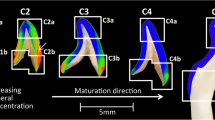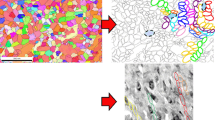Abstract
Growth of inorganic crystals of enamel is described as a two-stage process with growth of ribbon-like crystals in length and width, followed by their development in thickness. In early stages of crystal growth during human amelogenesis nanometer-sized particles with a mean diameter of 1.1 nm were described between ribbon-like crystals. These small particles had a crystalline structure but their lattice parameters did not seem to be directly related to those of calcium phosphates. The nanometer-sized particles appear to correspond to initial stages of apatite crystal growth. Their localization close to ribbon-like crystals and their progressive increase in size and number may indicate that they represent a precursor phase for these crystals. Nucleation areas at both extremities, of elongated ribbon-like crystals could be involved in the two-directional growth of ribbons and/or in nanometer-sized particle nucleation.
Similar content being viewed by others
References
Aoba T, Moreno EC (1990) Changes in the nature and composition of enamel mineral during porcine amelogenesis. Calcif Tissue Int 47:356–364
Artal P, Avalas-Borja M, Soria F, Poppa H, Heineman K (1989) Image processing enhancement of high resolution TEM micrographs of nanometer-sized metal particles. Ultramicroscopy 30:405–416
Brès EF, Voegel J-C, Frank RM (1990) High resolution electron microscopy of human enamel crystals. J Microsc 160:183–201
Brès EF, Hutchison JL, Senger B, Voegel J-C, Frank RM (1991) Study of irradiation damages in human dental enamel crystals. Ultramicroscopy 35:305–322
Brown WE (1965) A mechanism for growth of apatitic crystals. In: Stack MV, Fearnhead RW (eds) Tooth enamel I. John Wright, Bristol, pp 11–14
Cesari C, Charai A, Nihoul C (1985) Can nano-crystallites of germanium be structure-imaged? Ultramicroscopy 18:291–296
Choi E (1990) Characterization of nanometer sized particles. PhD Thesis, Purdue University, USA
Christner PJ, Lally ET, Miller RD, Leontzwitch P, Rosenbloom J, Herold RC (1985) Monoclonal antibodies to different epitopes in amelogenins from fetal bovine teeth recognize high molecular weight components. Arch Oral Biol 30:849–854
Cuisinier FJG, Steuer P, Frank RM, Voegel J-C (1990) High resolution electron microscopy of young apatite crystals in human fetal enamel. J Biol Buccale 18:149–154
Cuisinier FJG, Glaisher RW, Voegel J-C, Hutchison J, Brès E, Frank RM (1991) Compositional variations in apatites with respect to preferential ionic extraction. Ultramicroscopy 36:297–300
Cuisinier FJG, Steuer P, Senger B, Voegel J-C, Frank RM (1992a) Human amelogenesis I: High resolution electron microscopy study of ribbon-like crystals. Calcif Tissue Int 51:259–268
Cuisinier FJG, Voegel J-C, Apfelbaum F, Mayer I (1992b) High resolution electron microscopy study of Ga-containing carbonate apatite. J Crystal Growth 125:1–6
Daculsi G, Kerebel LM (1978) High resolution electron microscope study of human enamel crystallites: size, shape and growth. J Ultrastruct Res 65:163–172
Eastoe JE (1964) The chemical composition of bone and tooth. Adv Fluorine Res Dent Caries Prevent 3:5–16
Hayashi Y, Bianco P, Shimokawa H, Termine JD, Bonucci E (1986) Organic-inorganic relationships, immunohistochemical localization of amelogenins and enamelins in developing enamel. Basic Appl Histochem 30:291–299
Heineman K, Soria F (1986) On the detection and size classification of nanometer-sized metal particles on amorphous substrates. Ultramicroscopy 20:1–14
Höhling HJ, Kreilos R, Neubauer G, Boyde A (1971) Electron microscopy and electron microscopical measurements of collagen mineralization in hard tissues. Z Zellforsch 112:36–52
Höhling HJ, Krefting ER, Barkhaus (1982) Does correlation exist between mineralization in collagen-rich hard tissues and that in enamel? J Dent Res 61:1496–1503
Meldrum FC, Wade VJ, Nimmo DL, Heywood BR, Mann S (1991) Synthesis of inorganic nanophase materials in supramolecular protein cages. Nature 349:684–687
Plate U, Höhling HJ (1993) Analysis of the early formation and crystal maturation in dentine of rat incisors by ESI and ESD. Electron Microscopy (EUREM 92) vol 3, pp 607–611
Ramos A, Gandais M (1989) First stages of crystallization in a silicate glass: study by high-resolution electron microscopy. J Electron Microsc Tech 11:238–241
Rey C, Shimizu M, Collins B, Glimcher MJ (1990) Resolution-enhanced Fourier transform infrared spectroscopy study of the environment of phosphate ions in the early deposits of a solid phase of calcium-phosphate in bone and enamel, and their evolution with age. Investigation in the V4PO4 domain. Calcif Tissue Int 46:384–394
Roberts JE, Bonar LC, Griffin RG, Glimcher MJ (1992) Characterization of very young mineral phases of bone by solid state 31phosphorus magic angle sample spinning nuclear magnetic resonance and X-ray diffraction. Calcif Tissue Int 50:42–48
Rönnholm E (1962) The amelogenesis of human teeth as revealed by electron microscopy. II The development of the enamel crystallites. J Ultrastruct Res 6:249–303
Scherzer O (1949) The theoretical resolution limit of the electron microscope. J Appl Phys 20:20–29
Senger B, Brès EF, Hutchison JL, Voegel J-C, Frank R (1992) Ballistic damages induced by electrons in hydroxyapatite (OHAP). Phil Mag A 65:665–682
Shimokawa H, Ogata Y, Sasaki M, Sobel ME, McQuillan CI, Termine JD, Young MF (1987) Molecular cloning of bovine amelogenin cDNA. Adv Dent Res 2:293–297
Siew C, Grunninger SE, Chow LC, Brown WE (1992) Procedure for the study of acidic calcium phosphate precursor in enamel mineral formation. Calcif Tissue Int 50:144–148
Spence JCH (1981) Experimental high-resolution electron microscopy. Oxford University Press, Oxford
St Pierre TG, Webb J, Mann S (1989) Ferritin and hemosiderin: structural and magnetic studies of the iron core. In: Mann S, Webb J, Williams RPL (eds) Biomineralization. VCH, Weinheim, pp 295–335
Termine JD, Belcourt AB, Christner PJ (1980) Properties of dissociatively extracted fetal tooth matrix proteins. I Principal molecular species in developing bovine enamel. J Biol Chem 225:9760–9768
Weiss MP, Voegel J-C, Frank RM (1981) Enamel crystallite growth: width and thickness study related to the possible presence of octocalcium phosphate during amelogenesis. J Ultrastruct Res 76:286–292
Young RA, Brown WE (1982) Structures of biological minerals. In: Nancollas GH (ed) Biological mineralization and demineralization. Springer, Berlin, pp 101–141
Author information
Authors and Affiliations
Rights and permissions
About this article
Cite this article
Cuisinier, F.J.G., Steuer, P., Senger, B. et al. Human amelogenesis: high resolution electron microscopy of nanometer-sized particles. Cell Tissue Res 273, 175–182 (1993). https://doi.org/10.1007/BF00304624
Received:
Accepted:
Issue Date:
DOI: https://doi.org/10.1007/BF00304624




